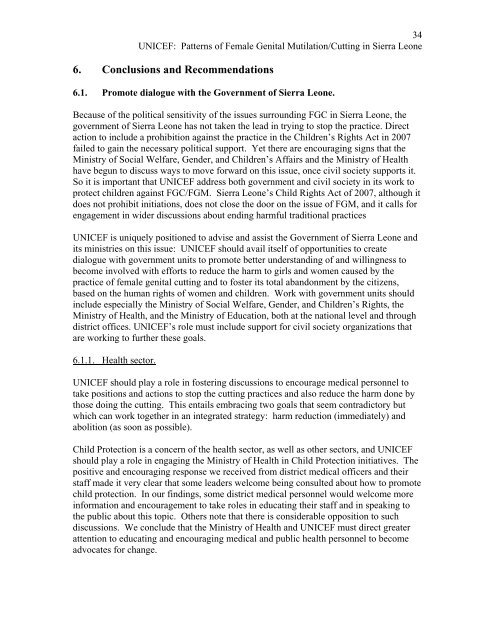Patterns of Female Genital Cutting in Sierra Leone - Unicef
Patterns of Female Genital Cutting in Sierra Leone - Unicef
Patterns of Female Genital Cutting in Sierra Leone - Unicef
You also want an ePaper? Increase the reach of your titles
YUMPU automatically turns print PDFs into web optimized ePapers that Google loves.
34<br />
UNICEF: <strong>Patterns</strong> <strong>of</strong> <strong>Female</strong> <strong>Genital</strong> Mutilation/<strong>Cutt<strong>in</strong>g</strong> <strong>in</strong> <strong>Sierra</strong> <strong>Leone</strong><br />
6. Conclusions and Recommendations<br />
6.1. Promote dialogue with the Government <strong>of</strong> <strong>Sierra</strong> <strong>Leone</strong>.<br />
Because <strong>of</strong> the political sensitivity <strong>of</strong> the issues surround<strong>in</strong>g FGC <strong>in</strong> <strong>Sierra</strong> <strong>Leone</strong>, the<br />
government <strong>of</strong> <strong>Sierra</strong> <strong>Leone</strong> has not taken the lead <strong>in</strong> try<strong>in</strong>g to stop the practice. Direct<br />
action to <strong>in</strong>clude a prohibition aga<strong>in</strong>st the practice <strong>in</strong> the Children’s Rights Act <strong>in</strong> 2007<br />
failed to ga<strong>in</strong> the necessary political support. Yet there are encourag<strong>in</strong>g signs that the<br />
M<strong>in</strong>istry <strong>of</strong> Social Welfare, Gender, and Children’s Affairs and the M<strong>in</strong>istry <strong>of</strong> Health<br />
have begun to discuss ways to move forward on this issue, once civil society supports it.<br />
So it is important that UNICEF address both government and civil society <strong>in</strong> its work to<br />
protect children aga<strong>in</strong>st FGC/FGM. <strong>Sierra</strong> <strong>Leone</strong>’s Child Rights Act <strong>of</strong> 2007, although it<br />
does not prohibit <strong>in</strong>itiations, does not close the door on the issue <strong>of</strong> FGM, and it calls for<br />
engagement <strong>in</strong> wider discussions about end<strong>in</strong>g harmful traditional practices<br />
UNICEF is uniquely positioned to advise and assist the Government <strong>of</strong> <strong>Sierra</strong> <strong>Leone</strong> and<br />
its m<strong>in</strong>istries on this issue: UNICEF should avail itself <strong>of</strong> opportunities to create<br />
dialogue with government units to promote better understand<strong>in</strong>g <strong>of</strong> and will<strong>in</strong>gness to<br />
become <strong>in</strong>volved with efforts to reduce the harm to girls and women caused by the<br />
practice <strong>of</strong> female genital cutt<strong>in</strong>g and to foster its total abandonment by the citizens,<br />
based on the human rights <strong>of</strong> women and children. Work with government units should<br />
<strong>in</strong>clude especially the M<strong>in</strong>istry <strong>of</strong> Social Welfare, Gender, and Children’s Rights, the<br />
M<strong>in</strong>istry <strong>of</strong> Health, and the M<strong>in</strong>istry <strong>of</strong> Education, both at the national level and through<br />
district <strong>of</strong>fices. UNICEF’s role must <strong>in</strong>clude support for civil society organizations that<br />
are work<strong>in</strong>g to further these goals.<br />
6.1.1. Health sector.<br />
UNICEF should play a role <strong>in</strong> foster<strong>in</strong>g discussions to encourage medical personnel to<br />
take positions and actions to stop the cutt<strong>in</strong>g practices and also reduce the harm done by<br />
those do<strong>in</strong>g the cutt<strong>in</strong>g. This entails embrac<strong>in</strong>g two goals that seem contradictory but<br />
which can work together <strong>in</strong> an <strong>in</strong>tegrated strategy: harm reduction (immediately) and<br />
abolition (as soon as possible).<br />
Child Protection is a concern <strong>of</strong> the health sector, as well as other sectors, and UNICEF<br />
should play a role <strong>in</strong> engag<strong>in</strong>g the M<strong>in</strong>istry <strong>of</strong> Health <strong>in</strong> Child Protection <strong>in</strong>itiatives. The<br />
positive and encourag<strong>in</strong>g response we received from district medical <strong>of</strong>ficers and their<br />
staff made it very clear that some leaders welcome be<strong>in</strong>g consulted about how to promote<br />
child protection. In our f<strong>in</strong>d<strong>in</strong>gs, some district medical personnel would welcome more<br />
<strong>in</strong>formation and encouragement to take roles <strong>in</strong> educat<strong>in</strong>g their staff and <strong>in</strong> speak<strong>in</strong>g to<br />
the public about this topic. Others note that there is considerable opposition to such<br />
discussions. We conclude that the M<strong>in</strong>istry <strong>of</strong> Health and UNICEF must direct greater<br />
attention to educat<strong>in</strong>g and encourag<strong>in</strong>g medical and public health personnel to become<br />
advocates for change.

















